Take home messages
- Pulses, particularly lentils and chickpeas, were very profitable at Mallee trial sites in 2016.
- When choosing new varieties or changing agronomic treatments it is important to look at
long-term information rather than individual seasons. Varieties like PBA Jumbo2 lentils have
performed well across a range of seasons, indicating yield stability. - New faba bean lines will offer opportunities for growers in the Mallee with profitable yields
(>140% of PBA Samira) produced in both dry (2015) and wet (2016) seasons.
Background
The Southern Pulse Agronomy program conducts a wide range of agronomic and variety pulse trials across all rainfall zones of Victoria and South Australia. Its primary aim is to improve yield and yield stability, ultimately leading to increased profitability and adoption of new varieties by growers. In this report, key results from selected trials conducted in the southern (Curyo) and central (Ouyen) Mallee in 2016 are highlighted. Further details relating to trial methodology and other measurements recorded will be available in a detailed report by May 2017.
Lentils
A range of higher yielding lentil varieties have been released, with improvements in a range of agronomic traits including biomass development, canopy structure, disease resistance, herbicide tolerance, maturity and pod retention. In addition, growers are sowing crops earlier to maximise yield potential and reduce risks of heat and terminal drought stress, particularly in the Mallee.
Research in 2016, similar to 2015, focused on identifying potential advantages of lower seeding rates for these new varieties and its interaction with sowing date (at Curyo only), without incurring yield penalties.
Several new breeding lines were also compared at the traditional sowing rate of 120 plants/m2.
Chickpeas
Trials in 2016 focused on identifying the potential yield loss from this new ascochyta blight pathotype on a range of varieties and new breeding lines (data presented in ‘Disease in pulse crops’, page 148). At Ouyen, earlier maturing breeding lines and varieties were assessed for adaptability to crop topping.
Faba beans
In the breeding program, several lines with significant improvements in yield in dry areas have been identified. At Curyo in the dry season of 2015 the line AF12025 yielded 158 per cent of PBA Samira.
Improved moisture conservation techniques mean that, beans may be considered within the farming system, particularly as they are one of the best nitrogen fixing pulses.
In 2016, similar to 2015, a number of new breeding lines and a range of planting densities were tested to maximise yields at both Curyo and Ouyen.
Lupins
A number of breeding lines from trials in 2015 were selected with potential adaptive traits for south eastern Australia. At the central Mallee site (Ouyen) a range of breeding lines were assessed to identify those more suitable for the modern farming systems used in Mallee regions.
In addition, a trial assessed the impact of sowing depth and plant density on the growth and yield of Mandelup lupin.
Aim
To improve yield and yield stability of pulse crops, ultimately leading to increased profitability
and adoption of new varieties by growers.
Paddock details
| Location: | Curyo and Ouyen |
| Annual rainfall: | Curyo – 356mm, Ouyen – 335mm |
| GSR (Apr-Oct): | Curyo – 471mm, Ouyen – 410mm |
| Soil type: | Curyo – Sandy loam; Ouyen – Loamy sand |
| Crop types: | See Table 1 |
| Sowing dates: | Curyo 4 May (2 June for delayed sowing lentil trial) Ouyen 5 and 6 May |
| Sowing system: | Inter-row with narrow points and press wheels in a no-till system (row spacing: Ouyen – 30cm; Curyo – 36.5cm) |
| Harvest dates: | Curyo November 29 and 30
December 1 (lentils, peas and beans) December 22 (chickpeas) November 20 and 21 (lentils and beans) November 28 (chickpeas and lupins) |
Table 1. Overview of agronomic trials at Curyo and Ouyen in 2016.

Climate
Table 2. Temperatures and rainfall at Curyo 2016.
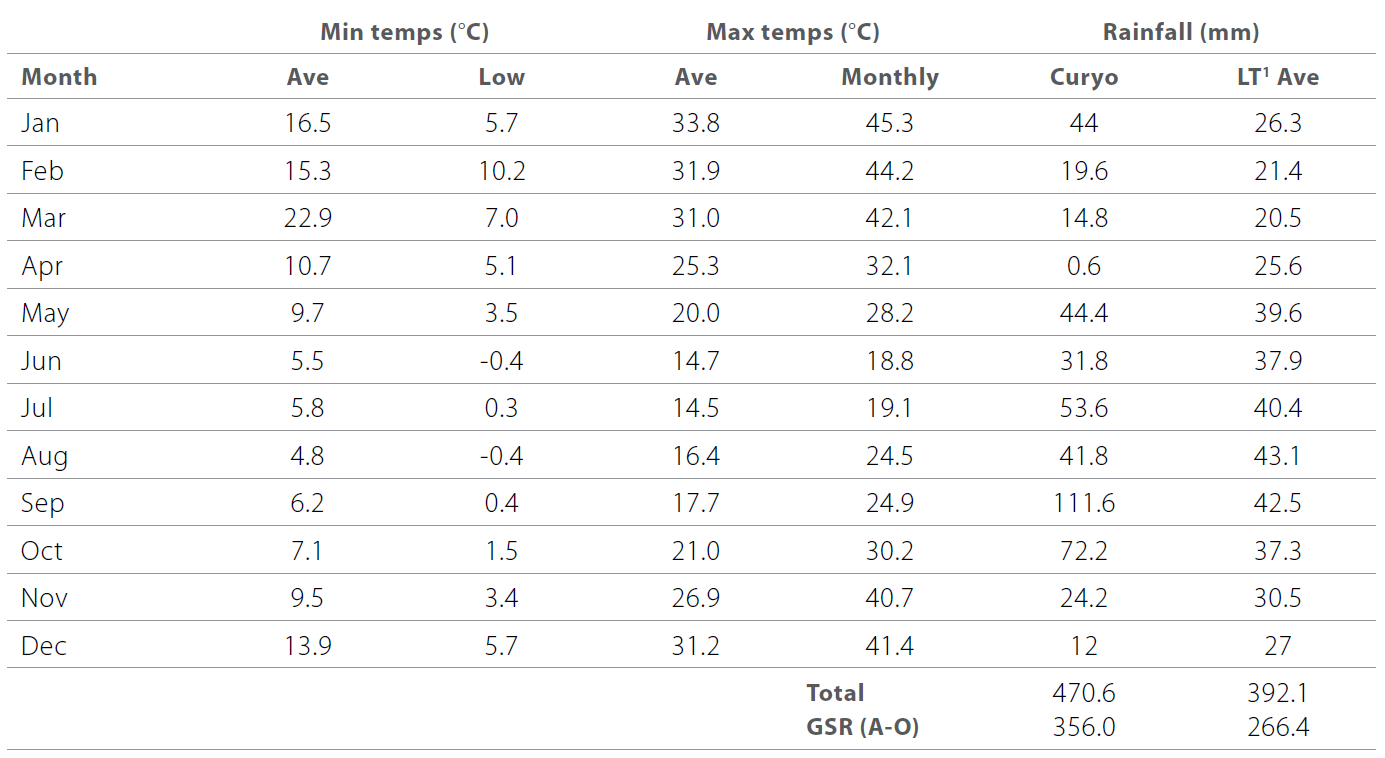
1. Long-term average at Warracknabeal (1969-2016).
Table 3. Temperatures and rainfall at Ouyen 2016.
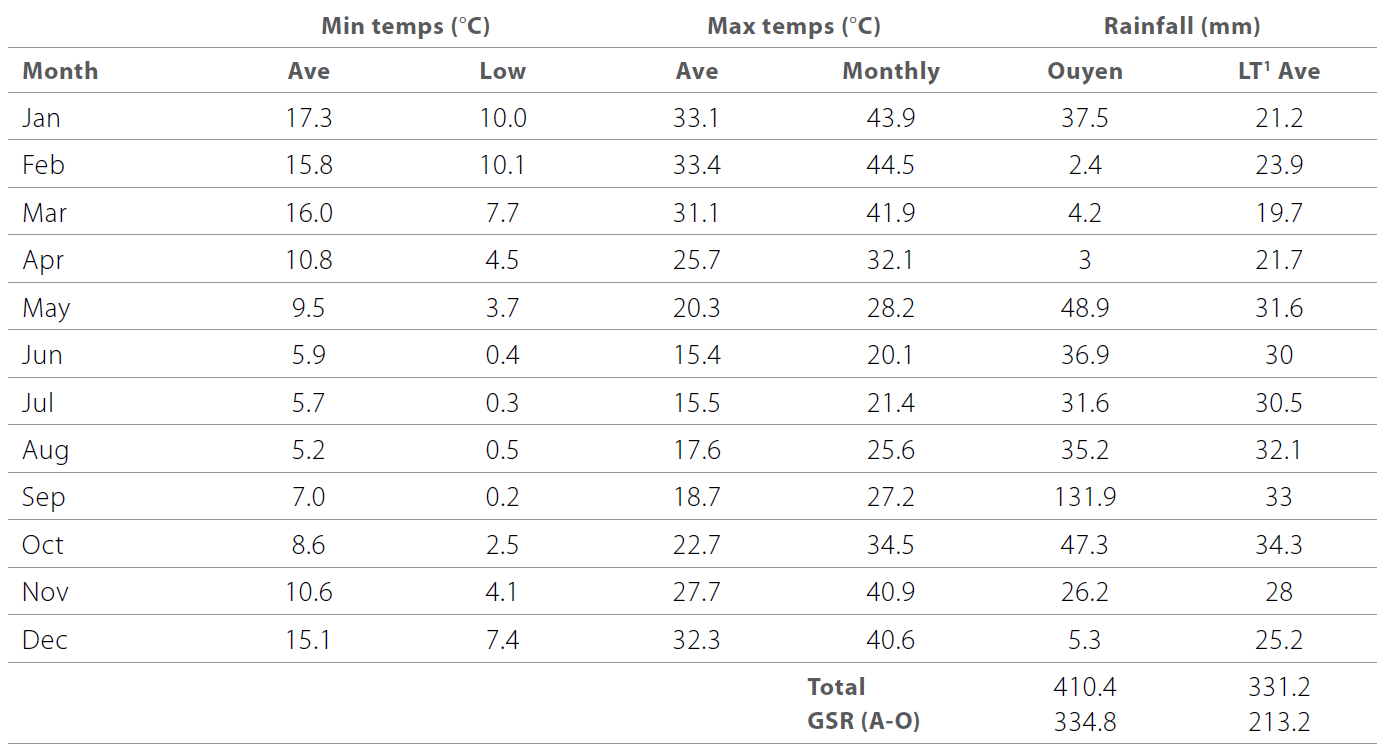
Results and interpretation
Lentils
Due to the extremely high rainfall at Curyo in 2016 and the development of large canopies in lentils, a moderate to severe outbreak of botrytis grey mould (BGM) was observed. No fungicides were applied to these trials to ensure a clear understanding of the relative resistance of varieties and breeding lines under high disease pressure. The findings from this work are presented in ‘Disease in pulse crops’, page 148.
No disease was observed at Ouyen.
Grain yields ranged between 1.75 and 4.04t/ha at Curyo and 1.82 and 3.32t/ha at Ouyen.
Relative rankings of varieties varied between sowing dates and sites (Figure 1). At Curyo, PBA Jumbo2 was the highest yielding variety sown May 4 (4.04t/ha) and June 2 (3.40t/ha), but at Ouyen, its yield was mid-range (2.63t/ha) and significantly less than the breeding line L5 (3.32t/ha).
Conversely, L5 was the lowest yielding line at Curyo (1.75t/ha, May 4 and 2.37t/ha, June 2) indicative of its susceptibility to BGM. PBA Bolt also performed relatively poorly due to its BGM susceptibility, with yields 50 per cent and 22 per cent less than PBA Jumbo2 at Curyo sown May 4 and June 2, respectively.
At Ouyen, it was notable that PBA HurricaneXT was the highest yielding of the released varieties, similar to PBA Ace and PBA Jumbo. This may indicate differential tolerance to soil types as the soil was significantly sandier than at Curyo and no group B chemicals had been used at that site for several years.
It has been observed in industry that PBA HurricaneXT appears to perform better than other varieties over sand hills. Further work is planned to investigate potential adaptation.
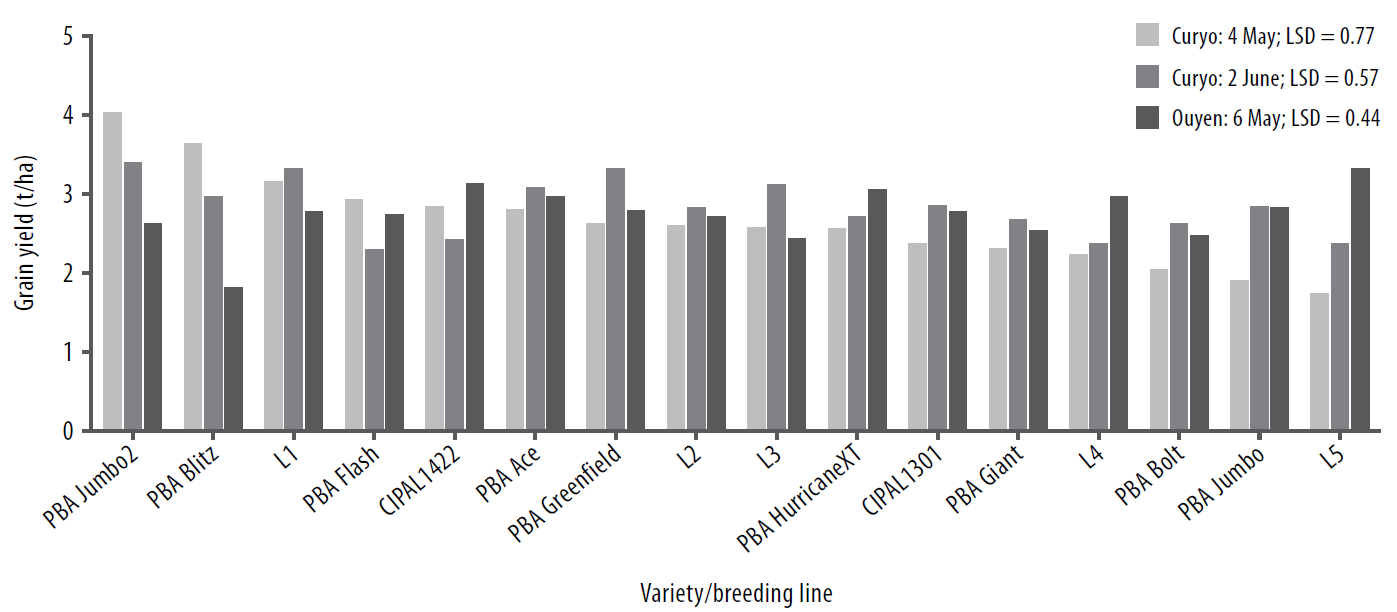
Figure 1. Grain yield of lentil varieties and breeding lines sown at two sowing dates at Curyo and one date at Ouyen in 2016.
The seeding rate trials, showed a significant interaction between plant density and BGM intensity. The findings from this work are presented in ‘Disease in pulse crops’, page 148.
Chickpeas
At Curyo, in late July a significant outbreak of ascochyta blight was observed in all chickpea trials. However, despite the high levels of disease observed, several varieties and breeding lines were able to partially recover during November and December to produce adequate grain yield (Table 4), highlighting the ability of chickpeas to recover from disease, once conditions dry out.
The yields in the fortnightly fungicide treatment were lower than could be expected given the
rainfall, ranging from 2.06t/ha for Neelam to 0.99t/ha for Kalkee. This is likely to be related to the excessive biomass that was produced prior to flowering and the ongoing cold conditions during the reproductive phase, which meant many flowers and pods were aborted. The desi’s were generally higher yielding than the kabuli’s.
The impact of ascochyta blight on chickpea yield is discussed further in ‘Disease in pulse crops’, page 148.
Table 4. Ascochyta blight disease score (Oct 25) in the ‘nil’ fungicide treatment and grain yield of chickpeas in the ‘nil’ and ‘fortnightly’ (8 sprays) fungicide treatment at Curyo in 2016. Underlined values indicate statistically significant reduction compared with the fortnightly.
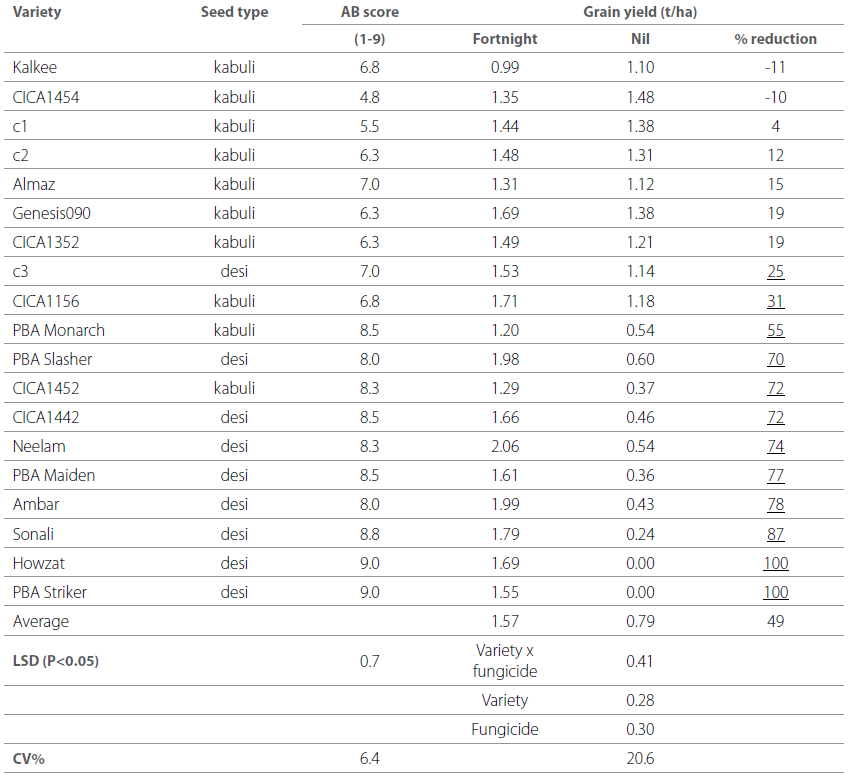
At Ouyen, crop topping had no effect on the chickpeas. Grain yields ranged between 2.48t/ha for Neelam to 1.98t/ha for Howzat (Table 5).
Although desi’s generally had higher yields than kabuli’s, the estimated net returns of kabuli’s were higher. Given the price of grain, chickpeas could have produced up to $2400/ha net return in 2016.
Table 5. Grain yield and estimated net return of chickpeas sown at Ouyen in a crop-topping trial 2016. *Net return based on production costs of $330/ha and returns on grain of $1300/t for kabuli’s and $900/t for desi’s.
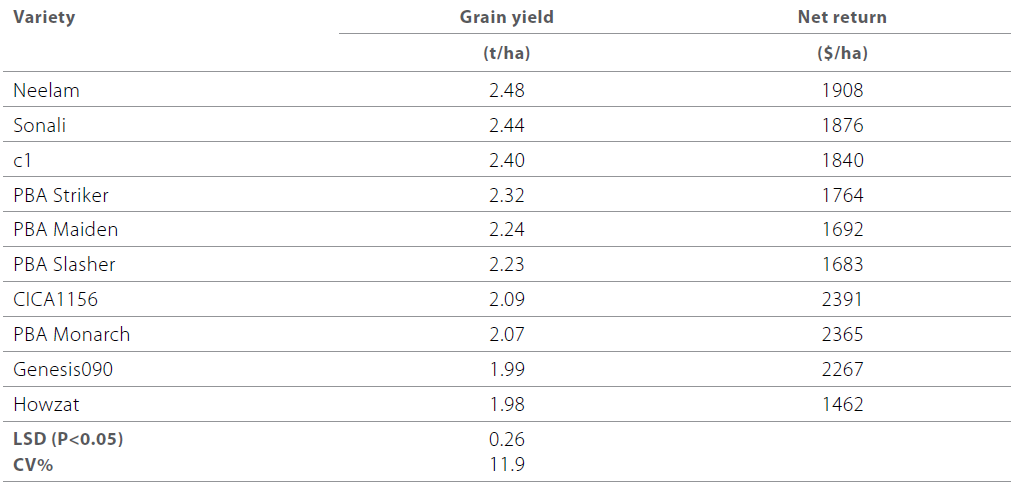
Faba beans
The performance of several new faba bean lines identified for improvements in drought resistance was again excellent at Curyo in 2016 (Table 6). All of the ‘AF12-‘series lines had higher grain yields than PBA Samira (4.12t/ha), except AF12038, with AF12025 (5.75t/ha) achieving 140 per cent of PBA Samira. AF12025 was also the highest yielding line in the drought conditions of 2015.
In addition, the beans were the best of the pulses in tolerating waterlogging at Curyo and displayed very high biomass, meaning nitrogen fixation was likely to be extremely high (estimated to be 200-300kg/ha).
A sowing rate experiment compared AF012025 and PBA Samira at densities ranging from 5-30 plants/m2. Consistent with recommendations, 20 plants/m2 was the optimum density to maximise grain yield in beans (Figure 2).
A similar trial was sown at Ouyen, but unfortunately there were issues with equipment resulting in variable establishment and missing rows, meaning trials could not be analysed. Despite all the issues, it was estimated that beans had grain yield between 2-3t/ha.
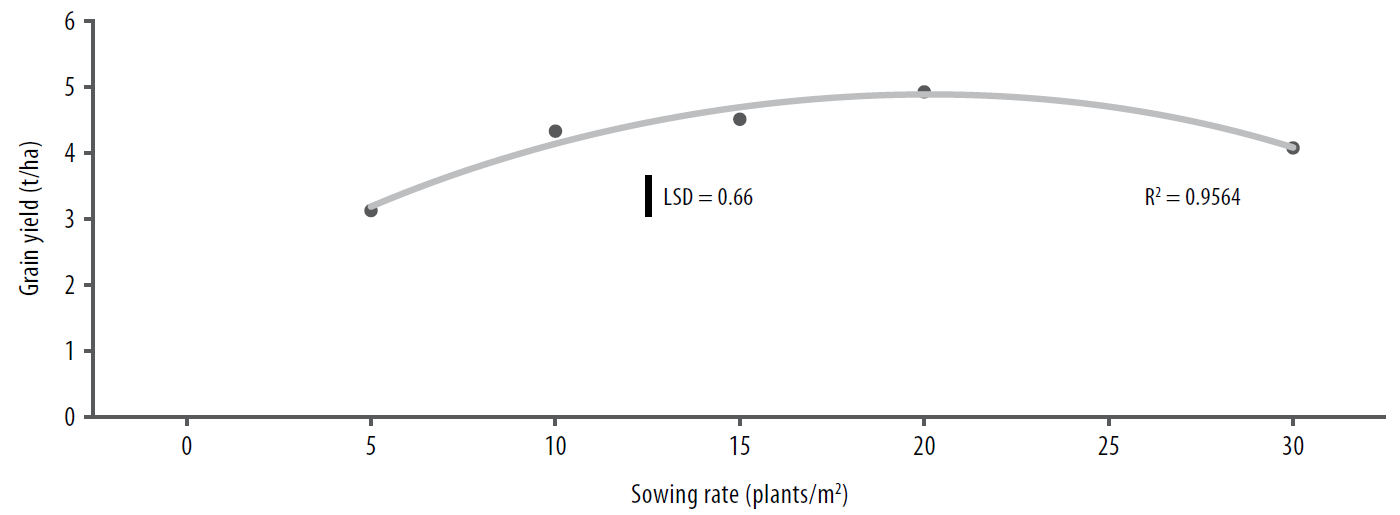
Figure 2. Average grain yield of faba beans at various plant densities at Curyo in 2016.
Table 6. Biomass at maturity, grain yield, harvest index and estimated net return of faba beans sown at Curyo in a trial focusing on lines with improved drought resistance in 2016. Net return based on production costs of $240/ha and returns on grain of $230/t.
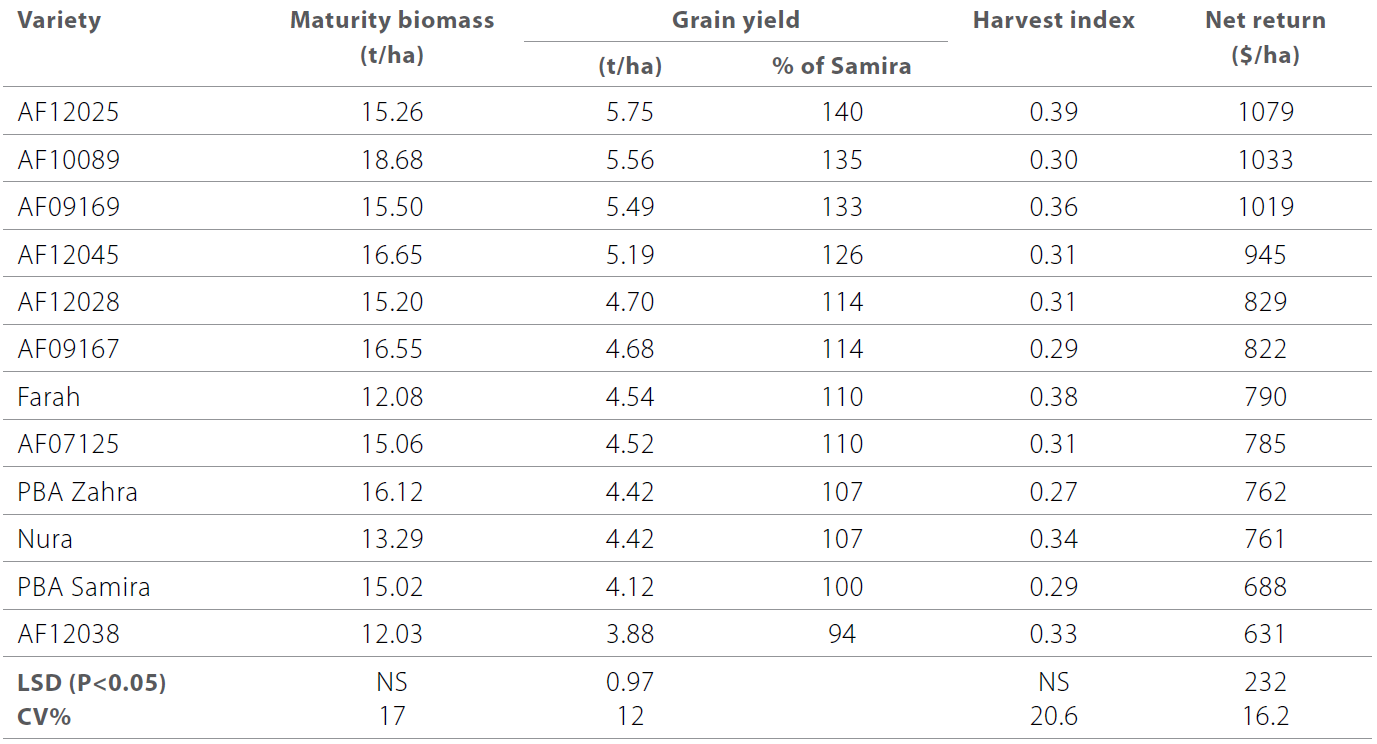
Lupins
At Ouyen, sowing seed deeper than three centimetres reduced establishment and grain yield by approximately 30 to 45 per cent (Figure 3).
At the 3cm depth actual plant density was similar to targeted density and grain yield averaged 2.32t/ha across all densities. There was no statistically significant difference in grain yield between the sowing rates.
By comparison, at both eight and 13cm sowing depth, actual plant densities were generally lower than targeted densities. Grain yields were significantly lower at the 20 plants/m2 sowing rate compared with other rates.
Sowing depth results are consistent with previous observation in industry and indicate the need to develop varieties with improved tolerance to deeper sowing to allow greater flexibility in dry Mallee conditions.
Grain yields of the early generation breeding lines at Ouyen generally ranged between 2.4 and 3.5t/ha. PBA Barlock was the highest yielding commercial variety.

Figure 3. Establishment and grain yield of lupin (Mandelup) sown at three depths and four plant densities at Ouyen in 2016.
Table 7. Grain yield and estimated net return of lupin breeding line and varieties sown at Ouyen in 2016, focusing on lines with improved adaptation to Mallee conditions. Net return based on production costs of $260/ha and returns on grain of $260/t.

Commercial practice
Lentils
Similar to previous seasons PBA Jumbo2 performed extremely well in 2016, highlighting its yield stability for Mallee both dry and wet conditions. It is a variety that minimises disease risks and benefits from sowing early to maximise yield potential. Potential net returns, based on yields in the Curyo trial in 2016 were around $2500/ha.
Good disease management is critical to maximise yield and quality, particularly varieties with resistance rating less than ‘R’. Applying the appropriate preventative fungicide early and prior to canopy closure can minimise disease pressure and reduce losses. It is estimated that in susceptible varieties BGM resulted in a yield loss of 1-1.5t/ha ($650-$975/ha).
Similar to 2015 lowering the seeding rate of lentils, from 120 plants/m2 to 80 plants/m2 is viable, particularly with early sowing and the use of varieties like PBA Jumbo2, but significant yield reductions have been observed in drier seasons below 80 plants/m2 and with delayed sowing.
New lines with consistently high yields, herbicide tolerance, good biomass, disease resistance and earlier maturity similar will be available in the next few years.
Results from the trial site at Ouyen indicate significant opportunities to improve the adaptation to the sandier Mallee soil types. Further work will occur to understand the response of lentils across the tops of sand hills and the heavier flats. It is important to always choose the better soil types to minimise crop failure in lentils, particularly avoiding sub-soil constraints.
Lentils are a highly profitable crop and proving to be increasingly reliable in the Mallee as we improve varieties and agronomy and while prices are good. Growers always need to be aware of possible price swings and to remember that the long-term price average for lentils is between $500 and $600/t.
Chickpeas
The virulence of the new isolate of ascochyta blight was assessed at Curyo and confirmed to cause significant symptoms (including stem breakages) on all varieties and breeding lines. Grain yield loss in the most susceptible varieties and breeding lines was up to 100 per cent, however the level of resistance in a number of kabuli’s including Gensis090, means that the disease can still be proactively managed with fungicides to ensure profitable grain yields are produced.
Growers are encouraged to closely monitor all chickpeas crops in 2017 and use an early preventative fungicide strategy to minimise risks of disease, and prevent ongoing reinfection throughout the season.
Faba beans
New faba bean lines will offer opportunities for growers in the Mallee, with profitable yields, significantly higher than commercial varieties, produced in both dry (2015) and wet (2016) seasons. Marketing of grain is likely to be the biggest issue in expanding production as currently there are limited international markets and over production results in low grain prices (eg. $230/t this year compared with >$450/t in 2015).
As one of the best nitrogen fixing pulse crops, beans could also provide opportunities as a brown manure crop, particularly when sown early.
Lupins
Consistent with previous option this research suggest growers should sow their lupins as shallow as practical and at a consistent depth. With early sowing and wet conditions, lower sowing rates could potentially be used.
Several new breeding lines appear to be higher yielding than the traditional commercial variety Mandelup, so growers are encouraged to look for new options as they become available. Further work from breeding companies needs to occur to develop improved plant types and resulting yields for the Victorian and South Australian Mallee.
Acknowledgements
This research was funded by GRDC, AgVic and SARDI (DAV00150).
Contact details
Dr Jason Brand
Senior Research Agronomist – Pulses, DEDJTR, 110 Natimuk Rd, Horsham, Victoria 3401
M: 0409 357 076; E: jason.brand@ecodev.vic.gov.au; Twitter: @JasonBrand
